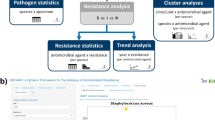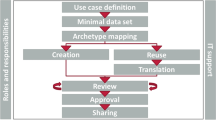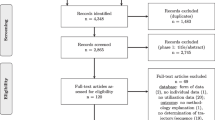Abstract
Identify the application of computational methods and algorithms reported in the literature based on four main categories including data mining, clinical decision support systems, geographical information systems, and digital dashboards and to summarize them in a qualitative scoping review. A scoping review was presented following Preferred Reporting Items for Systematic Reviews and Meta-Analyses guidelines. MEDLINE, Emerald, Scopus, and Google Scholar databases were searched in July 2016 using uniform keywords for documents that discuss data mining and knowledge discovery, dashboards, geographical information systems, and electronic surveillance of antimicrobial resistance in surveillance systems. Our study mainly focused on knowledge discovery and visualization algorithms, methods, and techniques used in antimicrobial resistance surveillance systems. Thirteen of the reviewed articles applied algorithms to the data mining process. A comparative table of data elements in the reviewed studies was extracted. The characteristics of antimicrobial dashboards were discussed. Heat maps were the most popular method used to visualize the intensity of resistance. Comparative tables are provided in each section of this paper. Data mining, Decision Support Systems, Geographic Information Systems, and dashboards can be integrated for data analysis and to better solve decision support problems. Bio-surveillance systems should be designed and analyzed based on four categories: data mining, dashboards, geography information system, and decision support modules. Furthermore, some questionnaires and checklists were developed and validated to capture related Business Intelligence and analytical requirements. Future studies should focus on developing fast, flexible, and accurate computational bio-surveillance systems by appropriate selecting and applying the considered methods and algorithms.





Similar content being viewed by others
References
Ahumada LM et al (2007) A visual analytics antibiogram dashboard as part of a comprehensive approach to perioperative antibiotic administration. Paper presented at the STA, Orlando
Altaf W, Shahbaz M, Guergachi A (2016) Applications of association rule mining in health informatics: a survey. Artif Intell Rev 47:1–28
Amábile-Cuevas CF (2007) Antimicrobial resistance in bacteria. Horizon Bioscience, Wymondham
Arya BK, Robert D, Bhattacharya SD, Mukhopadhyay J (2013) A framework for web based geographical information systems for country wide antimicrobial resistance monitoring. Health Policy Technol 2:85–93
Boolos GS, Burgess JP, Jeffrey RC (2007) Computability and logic. Cambridge University Press, Cambridge
Brossette SE, Sprague AP, Hardin JM, Waites KB, Jones WT, Moser SA (1998) Association rules and data mining in hospital infection control and public health surveillance. J Am Med Inform Assoc 5:373–381
Burke JP, Pestotnik SL (1999) Antibiotic use and microbial resistance in intensive care units: impact of computer-assisted decision support. J Chemother 11:530–535. https://doi.org/10.1179/joc.1999.11.6.530
Calloway S, Akilo HA, Bierman K (2013) Impact of a clinical decision support system on pharmacy clinical interventions, documentation efforts, and costs. Hosp Pharm 48:744
Chunara R, Andrews JR, Brownstein JS (2012) Social and news media enable estimation of epidemiological patterns early in the 2010 Haitian cholera outbreak. Am J Trop Med Hyg 86:39–45
Conly JM, Johnston BL (2005) Where are all the new antibiotics? The new antibiotic paradox. Can J Infect Dis Med Microbiol 16:159–160
Critchley I, Karlowsky J (2004) Optimal use of antibiotic resistance surveillance systems. Clin Microbiol Infect 10:502–511
Evans R, Classen DC, Pestotnik SL, Lundsgaarde HP, Burke JP (1994) IMproving empiric antibiotic selection using computer decision support. Arch Intern Med 154:878–884. https://doi.org/10.1001/archinte.1994.00420080076008
Evans RS, Classen DC, Pestotnik SL, Clemmer TP, Weaver LK, Burke JP (1995) A decision support tool for antibiotic therapy. In: Proceedings of the annual symposium on computer application in medical care. American Medical Informatics Association
Evans R et al (2015) Use of computer decision support in an antimicrobial stewardship program (ASP). Appl Clin Informat 6:120–135
Felmingham D (2002) The need for antimicrobial resistance surveillance. J Antimicrob Chemother 50(Suppl S1):1–7
Forrest GN, Van Schooneveld TC, Kullar R, Schulz LT, Duong P, Postelnick M (2014) Use of electronic health records and clinical decision support systems for antimicrobial stewardship. Clin Infect Dis 59:S122–S133
Freifeld CC, Chunara R, Mekaru SR, Chan EH, Kass-Hout T, Iacucci AA, Brownstein JS (2010) Participatory epidemiology: use of mobile phones for community-based health reporting. PLoS Med 7:e1000376
Galvin S, Bergin N, Hennessy R, Hanahoe B, Murphy AW, Cormican M, Vellinga A (2013) Exploratory spatial mapping of the occurrence of antimicrobial resistance in E. coli in the community. Antibiotics 2:328–338
Gerontini M, Vazirgiannis M, Vatopoulos AC, Polemis M (2011) Predictions in antibiotics resistance and nosocomial infections monitoring. In: Proceedings—IEEE symposium on computer-based medical systems. https://doi.org/10.1109/cbms.2011.5999112
Giannopoulou EG, Kemerlis VP, Polemis M, Papaparaskevas J, Vatopoulos AC, Vazirgiannis M (2007) A large scale data mining approach to antibiotic resistance surveillance. In: Twentieth IEEE international symposium on computer-based medical systems, 2007. CBMS’07, pp 439–444
Goff DA (2012) iPhones, iPads and medical applications for antimicrobial stewardship. Pharmacotherapy 32:657–661
Goldman E, Glynn E, Blackburn R, Newland J, Selvarangan R, Hoffman M (2015) Development of a real time, interactive antimicrobial resistance dashboard. Paper presented at the IDWeek, San Diego
Hacek DM, Cordell RL, Noskin GA, Peterson LR (2004) Computer-assisted surveillance for detecting clonal outbreaks of nosocomial infection. J Clin Microbiol 42:1170–1175
Han JH, Bilker WB, Edelstein PH, Mascitti KB, Lautenbach E (2013) Derivation and validation of clinical prediction rules for reduced vancomycin susceptibility in Staphylococcus aureus bacteraemia. Epidemiol Infect 141:165–173. https://doi.org/10.1017/s0950268812000295
Hand DJ (1998) Data mining: statistics and more? Am Stat 52:112–118
Hewapathirana R, Wijayarathna G (2009) Spatiotemporal antibiotic resistance pattern monitoring using geographical information system based hierarchical cluster analysis. Stud Health Technol Inform 160:501–504
Hewapathirana R, Wijayarathna G (2010) Using google maps to analyze spatio-temporal pattern of antibiotic resistance. Sri Lanka J Bio-Med Inform 1:28–34
Hoffman SJ et al (2015) An international legal framework to address antimicrobial resistance. Bull World Health Organ 93:66
Högberg LD (2012) EARS-Net: data collection and outputs. Paper presented at the ARHAI annual meeting, Berlin, Germany
Huh K et al (2016) Impact of monitoring surgical prophylactic antibiotics and a computerized decision support system on antimicrobial use and antimicrobial resistance. Am J Infect Control. https://doi.org/10.1016/j.ajic.2016.01.025
Joudaki H, Rashidian A, Minaei-Bidgoli B, Mahmoodi M, Geraili B, Nasiri M, Arab M (2014) Using data mining to detect health care fraud and abuse: a review of literature. Glob J Health Sci 7:194–202
Kiffer CR, Camargo EC, Shimakura SE, Ribeiro PJ, Bailey TC, Pignatari AC, Monteiro AM (2011) A spatial approach for the epidemiology of antibiotic use and resistance in community-based studies: the emergence of urban clusters of Escherichia coli quinolone resistance in Sao Paulo. Brasil Int J Health Geogr 10:1
Kolodner JL (1992) An introduction to case-based reasoning. Artif Intell Rev 6:3–34
Leibovici L, Gitelman V, Yehezkelli Y, Poznanski O, Milo G, Paul M, Ein-Dor P (1997) Improving empirical antibiotic treatment: prospective, nonintervention testing of a decision support system. J Intern Med 242:395–400
Leibovici L, Paul M, Nielsen AD, Tacconelli E, Andreassen S (2007) The TREAT project: decision support and prediction using causal probabilistic networks. Int J Antimicrob Agents 30(Suppl 1):S93–102. https://doi.org/10.1016/j.ijantimicag.2007.06.035
Litvin CB, Ornstein SM, Wessell AM, Nemeth LS, Nietert PJ (2013) Use of an electronic health record clinical decision support tool to improve antibiotic prescribing for acute respiratory infections: the ABX-TRIP study. J Gen Intern Med 28:810–816
Lombardo JS, Buckeridge DL (2012) Disease surveillance: a public health informatics approach. Wiley, Hoboken
López-Lozano J-M et al (2005) Applications of time-series analysis to antibiotic resistance and consumption data. In: Antibiotic policies. Springer, New York, pp 447–463
Lovis C, Colaert D, Stroetmann VN (2008) DebugIT for patient safety-improving the treatment with antibiotics through multimedia data mining of heterogeneous clinical data. Stud Health Technol Inform 136:641
Ma L, Tsui F-C, Hogan WR, Wagner MM, Ma H (2003) A framework for infection control surveillance using association rules. In: AMIA
Madaras-Kelly KJ, Hannah EL, Bateman K, Samore MH (2006) Experience with a clinical decision support system in community pharmacies to recommend narrow-spectrum antimicrobials, nonantimicrobial prescriptions, and OTC products to decrease broad-spectrum antimicrobial use. J Manag Care Pharm 12:390–397. https://doi.org/10.18553/jmcp.2006.12.5.390
Mainous AG, Lambourne CA, Nietert PJ (2013) Impact of a clinical decision support system on antibiotic prescribing for acute respiratory infections in primary care: quasi-experimental trial. J Am Med Inform Assoc 20:317–324
March ST, Hevner AR (2007) Integrated decision support systems: a data warehousing perspective. Decis Support Syst 43:1031–1043. https://doi.org/10.1016/j.dss.2005.05.029
McKee KT, Shields TM, Jenkins PR, Zenilman JM, Glass GE (2000) Application of a geographic information system to the tracking and control of an outbreak of shigellosis. Clin Infect Dis 31:728–733
Mirnia K, Soltani TS, Rezaei M, Heidarzadeh M, Piri Z (2014) Design and evaluation of electronic briefs of neonatal intensive care unit in Taleghani hospital, Tabriz. Iran Global Journal of Health Science 6:125
Moser SA, Jones WT, Brossette SE (1999) Application of data mining to intensive care unit microbiologic data. Emerg Infect Dis 5:454
Mullett CJ, Thomas JG, Smith CL, Sarwari AR, Khakoo RA (2004) Computerized antimicrobial decision support: an offline evaluation of a database-driven empiric antimicrobial guidance program in hospitalized patients with a bloodstream infection. Int J Med Informatics 73:455–460
Nabaei A, Hamian M, Parsaei MR, Safdari R, Samad-Soltani T, Zarrabi H, Ghassemi A (2016) Topologies and performance of intelligent algorithms: a comprehensive review. Artif Intell Rev 49:1–25
Obenshain MKMAT (2004) Application of data mining techniques to healthcare data. ICHE 25:690–695. https://doi.org/10.1086/502460
Paul M et al (2006) Prediction of bacteremia using TREAT, a computerized decision-support system. Clin Infect Dis 42:1274–1282
Pestotnik SL, Evans RS, Burke JP, Gardner RM, Classen DC (1990) Therapeutic antibiotic monitoring: surveillance using a computerized expert system. Am J Med 88:43–48
Peyman RH, Ahmadi M, Aziz R, Zahra S, Farahnaz S, Nader M (2012) Clinical care improvement with use of health information technology focusing on evidence based medicine. Healthc Inform Res 18:164–170. https://doi.org/10.4258/hir.2012.18.3.164
Poupard J, Brown J, Gagnon R, Stanhope MJ, Stewart C (2002) Methods for data mining from large multinational surveillance studies. Antimicrob Agents Chemother 46:2409–2419
Poupard JA, Gagnon RC, Stanhope MJ (2005) Data mining to discover emerging patterns of antimicrobic resistance. In: Antibiotic policies: theory and practice, pp 421–446. https://doi.org/10.1007/0-387-22852-7_23
Rahman RM, Hasan FRM (2011) Using and comparing different decision tree classification techniques for mining ICDDR B hospital surveillance data. Expert Syst Appl 38:11421–11436
Rodriguez-Maresca M, Sorlozano A, Grau M, Rodriguez-Castano R, Ruiz-Valverde A, Gutierrez-Fernandez J (2014) Implementation of a computerized decision support system to improve the appropriateness of antibiotic therapy using local microbiologic data. Biomed Res Int 2014:395434. https://doi.org/10.1155/2014/395434
Safdari R, GhaziSaeedi M, Masoumi-Asl H, Rezaei-Hachesu P, Mirnia K, Samad-Soltani T (2017) A national framework for an antimicrobial resistance surveillance system within Iranian healthcare facilities: towards a global surveillance system. J Glob Antimicrob Resist. https://doi.org/10.1016/j.jgar.2017.03.016
Safdari R, Saeedi MG, Masoumi-Asl H, Rezaei-Hachesu P, Mirnia K, Mohammadzadeh N, Samad-Soltani T (2018) National minimum data set for antimicrobial resistance management: toward global surveillance system. Iran J Med Sci
Samore MH et al (2005) Clinical decision support and appropriateness of antimicrobial prescribing: a randomized trial. JAMA 294:2305–2314
Schmidt R, Gierl L (2001) Case-based reasoning for antibiotics therapy advice: an investigation of retrieval algorithms and prototypes. Artif Intell Med 23:171–186
Schober D et al (2014) DebugIT: ontology-mediated layered data integration for real-time antibiotics resistance surveillance. In: SWAT4LS, 2014. Citeseer
Shebl NA, Franklin BD, Barber N (2007) Clinical decision support systems and antibiotic use. Pharm World Sci 29:342–349
Sim I, Gorman P, Greenes RA, Haynes RB, Kaplan B, Lehmann H, Tang PC (2001) Clinical decision support systems for the practice of evidence-based medicine. J Am Med Inform Assoc 8:527–534. https://doi.org/10.1136/jamia.2001.0080527
Sintchenko V, Iredell JR, Gilbert GL, Coiera E (2005) Handheld computer-based decision support reduces patient length of stay and antibiotic prescribing in critical care. J Am Med Inform Assoc 12:398–402. https://doi.org/10.1197/jamia.M1798
Stedtfeld RD et al (2016a) Antimicrobial resistance dashboard application for mapping environmental occurrence and resistant pathogens. FEMS Microbiol Ecol 92:fiw020
Stedtfeld RD et al (2016b) Antimicrobial resistance dashboard application for mapping environmental occurrence and resistant pathogens. FEMS Microbiol Ecol. https://doi.org/10.1093/femsec/fiw020
Steurbaut K et al (2010) Use of web services for computerized medical decision support, including infection control and antibiotic management, in the intensive care unit. J Telemed Telecare 16:25–29
Thursky KA et al (2006) Reduction of broad-spectrum antibiotic use with computerized decision support in an intensive care unit. Int J Qual Health Care 18:224–231
Tsui F-C et al (2002) Data, network, and application: technical description of the Utah RODS winter olympic biosurveillance system. In Proceedings of the AMIA symposium, pp 815–819
Wallace S, Damani N (2013) O022: development of an electronic dashboard to assist surveillance. Antimicrob Resist Infect Control 2:1
WHO (2014) Antimicrobial resistance: global report on surveillance. World Health Organization
WHO (2016) Global antimicrobial resistance surveillance system (GLASS): technical meeting on the early implementation phase: 22–23 October 2015: WHO Regional Office for Europe Copenhagen, Denmark: meeting report. World Health Organization
WHO (2017) Critically important antimicrobials for human medicine: ranking of antimicrobial agents for risk management of antimicrobial resistance due to non-human use. World Health Organization
Wisniewski MF, Kieszkowski P, Zagorski BM, Trick WE, Sommers M, Weinstein RA, the Chicago Antimicrobial Resistance P (2003) Development of a clinical data warehouse for hospital infection control. JAMIA 10:454–462. https://doi.org/10.1197/jamia.m1299
Zalounina A, Paul M, Leibovici L, Andreassen S (2007) A stochastic model of susceptibility to antibiotic therapy—the effects of cross-resistance and treatment history. Artif Intell Med 40:57–63. https://doi.org/10.1016/j.artmed.2006.12.007
Zhang C, Zhang S (2003) Association rule mining: models and algorithms. Springer, Berlin
Zheng X, Zhang Y-s, Huang Z-z, Jia Z, Duan H-l, Li H-m (2015) An integration framework for clinical decision support applications. In: Ubiquitous computing application and wireless sensor. Springer, New York, pp 543–552
Acknowledgements
Special thanks from www.SanamSahand.com knowledge -based company for providing scientific aids to synthesis current research.
Author information
Authors and Affiliations
Corresponding author
Rights and permissions
About this article
Cite this article
Safdari, R., GhaziSaeedi, M., Masoumi-Asl, H. et al. Knowledge discovery and visualization in antimicrobial resistance surveillance systems: a scoping review. Artif Intell Rev 53, 369–406 (2020). https://doi.org/10.1007/s10462-018-9659-6
Published:
Issue Date:
DOI: https://doi.org/10.1007/s10462-018-9659-6




